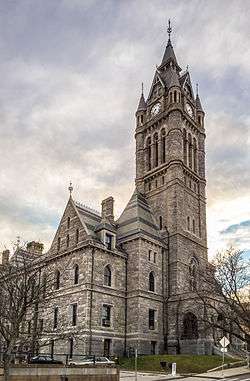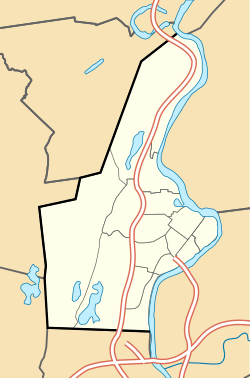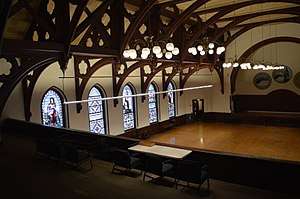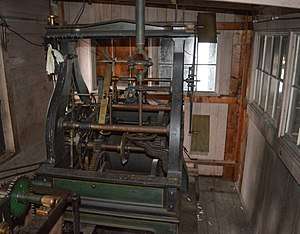Holyoke City Hall
|
Holyoke City Hall | |
 Holyoke City Hall | |
   | |
| Location | Holyoke, Massachusetts |
|---|---|
| Coordinates | 42°12′23″N 72°36′28″W / 42.20639°N 72.60778°WCoordinates: 42°12′23″N 72°36′28″W / 42.20639°N 72.60778°W |
| Area | 0.95 acres |
| Built | 1871 |
| Architect | Atwood, C.B.; et al. |
| Architectural style | Gothic Revival |
| Part of | North High Street Historic District (#92001725) |
| NRHP reference # | [1] |
| Significant dates | |
| Added to NRHP | December 6, 1975 |
| Designated CP | December 24, 1992 |
Holyoke City Hall is the historic city hall of Holyoke, Massachusetts. It is located at 536 Dwight Street, on the south east corner of High Street and Dwight Street. Serving both as the administrative center and a public timepiece for the industrial city's workers, construction began on the Gothic Revival structure in 1871 to a design by architect Charles B. Atwood. Difficulties and delays in construction were compounded by Atwood's failure to deliver updated drawings in a timely manner, and the design work was turned over to H. F. Kilburn in 1874. The building was completed two years later at a cost of $500,000. It has housed city offices since then.[2]

City Hall is a large stone structure in the Gothic Revival style, built with granite quarried in Monson. Basically rectangular in shape, it has transept-like wings on both long sides, near the ends. It has pointed-arch windows, and is structurally supported by Gothic buttresses. The roof is predominantly dark slate, with bands of red and green slate interspersed. The main tower is 220 feet (67 m) tall, and houses a bell weighing over 4,000 pounds (1,800 kg).[2]
During the late 19th and early 20th centuries, the building served as the de facto hub of the Holyoke Street Railway, as all trolley lines converged there, with zone fares based on the distance between that location and the system's various stops.[3] From 1876 until 1902 the building was also home to the Holyoke Public Library until it moved to its current location.[4] In addition to housing city offices, its main second-floor ballroom has also been used as a public function space. It has been used school graduation ceremonies, theatrical productions, dances, receptions for foreign dignitaries,[5] and from 1912 until 1926 annually hosted the New York Philharmonic as well as at least one such performance by the Boston Symphony Orchestra.[6][7] It was converted into a basketball court in 1946, with these changes reversed in 1973 for the city's centennial.[2]
The building was listed on the National Register of Historic Places in 1975, and included in a boundary expansion of the North High Street Historic District in 1992.[1][2]
Clock tower
Originally done in blackwood with gold numbers, which many onlookers found difficult to read, today the hall's large clock tower contains four faces of Belgium milk glass. The movement, a Seth Thomas no. 14, 8 day mechanism installed in 1877,[8] contains all bronze components and is one of only three such clock movements sold by the company in New England.[2][9] The 2.5 ton bell was forged in 1875 by the Jones & Co. Troy Bell Foundry of Troy, New York, and contains a custom-built strike movement as the bell sits on a separate floor from the mechanism and the transmission room where the clock faces and lighting sits. In the 1930s the clock was electrified with General Electric motors to raise its counterweights.[2]

Up until the 1980s the clock and its bell were often used in special occasions, one of the last being a bell-strike during the re-lighting of the torch of the Statue of Liberty on July 4, 1986 by President Reagan.[10] However increasing maintenance costs and maintenance deference kept the clock from running much of the time in the latter half of 20th century, with one of the most notable problems being the collapse of a sub-ceiling above the bell chamber in 1975. Until a grate was put across the belfry, damage from birds remained a persistent problem, with one notable repair attempt leaving mechanics to fight off a reported 1,500 blackbirds that returned to roost during one evening in January 1982.[11] For several years the clock gears had also been lubricated with standard motor oil rather than a specialty lubricant, leading to the coagulation of residue on the gear teeth. One problem that prevented the use of the bell was the seepage of water into the wooden driveshaft case, causing it to expand and warp.[11]
While the exact date the clock stopped regularly functioning is unknown, after about 30 years of being out of service the mechanism was restored in the Spring of 2018 by local steeplejack and arborist Dave Cotton, and a UMass professor emeritus of English, John Nelson, who worked on the clock of the Old Chapel previously. On July 4, 2018, the clock was restarted with new face lighting and repaired electrical systems, all from donated components and time. Due to problems with its mechanics, the bell however does not function and no immediate plans have been put into place to restore it in the foreseeable future.[12]
See also
References
- 1 2 National Park Service (2008-04-15). "National Register Information System". National Register of Historic Places. National Park Service.
- 1 2 3 4 5 6 "MACRIS inventory record for Holyoke City Hall". Commonwealth of Massachusetts. Retrieved 2013-12-10.
- ↑ "Zone Fares Successful in Holyoke". Electric Railway Journal. New York: McGraw Publishing Company. April 10, 1920. p. 750.
- ↑ "History of the Holyoke Public Library, 1870-2013". Holyoke Public Library. Archived from the original on 2018-10-10. Retrieved 2018-10-12.
- ↑ "Snowshoe Clubs Honored; How the French Residents of Holyoke Received Their Canadian Friends". New York Herald. New York. January 26, 1888. p. 9.
- ↑ "Holyoke". Springfield Republican. Springfield, Mass. March 9, 1926. p. 9.
The increased sale of tickets the past few days for the concert to be given by the Boston Symphony orchestra at the city hall tomorrow night assures that there will be but few empty seats. As it is probably the only time the orchestra will come to Holyoke it affords a chance for music lovers that should not be missed
- ↑ "Results for "City Hall" "Holyoke"". Leon Levy Digital Archives, New York Philharmonic. 2018. Archived from the original on September 17, 2018.
- ↑ Massachusetts public clock directory (Report). National Association of Watch and Clock Collectors. p. 47.
- ↑ Illustrated catalogue of Seth Thomas, New Haven, E. N. Welch and Welch, Spring & Co., clocks. American Clock Company. 1878.
- ↑ Beetle, Janice (July 3, 1986). "Clock tower chimes to signal libery [sic] event". Springfield Union. Springfield, Mass. p. 6.
- 1 2 Hamilton, Walter (January 4, 1982). "Holyoke's City Hall clock catches up—one more time". Springfield Union. Springfield, Mass. p. 4.
- ↑ Cutts, Emily (July 3, 2018). "Northampton arborist, colleagues revive 143-year-old Holyoke City Hall clock". The Daily Hampshire Gazette. Northampton, Mass. Archived from the original on July 3, 2018.
| Wikimedia Commons has media related to Holyoke City Hall. |

